

Travel log South Africa, June 2nd-28th 2006
Friday 02.06
Thursday night we slept at Barbara’s house in Leiden. Friday morning 2nd at 7.00 we were on our way to Amsterdam airport. Notwithstanding pre-printed boarding cards, the KLM luggage check in took ages. Economy class passengers are treated like cattle and it is high time that we all go on strike to teach the air companies a lesson! After a quick cup of coffee in the incredibly grimy Schiphol restaurant, we kissed the Best, Gouda and Leiden families farewell, bought some books and boarded. Security checks delayed flight KL 0597 for an hour but shortly before 11.00 pm we were air born. Since the plane was not full, we had three seats and felt a little less crammed than usual. Still, 12 hours non stop economy class in a plane is far from a picnic. At 22.15 we found ourselves queuing at immigration in Cape Town. It turned out to be a “pole pole” experience and it was 23.15 before we collected our luggage. Luckily our pick up was still patiently waiting and shortly before midnight we arrived at the Villa Christina guest house. After a friendly welcome and a glass of wine for Paul we turned in.
Saturday 03.06
7.30 hours. Windy with a clear sky. From our patio we see the Atlantic Ocean and parts of the Cape Town waterfront. Directly behind us tower the bare rocks of the Table Mountain. Sheila, the Persian guest house cat, lies on her back and wants her belly scratched. After breakfast we take a taxi to Herz Rentals, where we hire a white Nissan Almera and then have a coffee and sandwich at the Victoria waterfront before doing some shopping in a very luxurious shopping mall. On our way back, Paul misjudges the space on his left side and runs the car over a high “stoep”. We damage a wheel rim and wheel cover. There goes our excess waver! After a quite afternoon we have a bite in a café near the municipal playing ground - lamb burger and ostrich burger with Amstel lager - and watch television. A typical rainbow nation movie: “the runner”.
Sunday 04.06
A late Sunday breakfast and then to the Cape of Good Hope (Kaap de Goede Hoop sounds much better!). We drive along the Atlantic coast first - Camps Bay, Hout Bay and Chapman’s peak. Part of this road is a toll road, but well worth paying for: the scenery is breath taking. Lunch in Noordhoek, a small and old Cape Dutch village. The pub - The Nag’s Head - serves excellent salads. Meta: air-dried ham and melon. Paul: smoked salmon and avocado. Four feet away from us a piglet turns on a spit, soon to be served to the hungry Sunday mob of white South Africans. Back in the car, Paul observes that it is almost a place we visited some years ago in the English Cotswolds, be it that there were considerably more Africans to be seen there than in Noordhoek in South Africa on a Sunday morning! From Noordhoek we follow a magnificent winding road along the Atlantic to Smitswinkel, where we enter the Cape of Good Hope National Park. A very impressive place of some 8000 hectares with a semi-arid and Mediterranean character. Rocks, shrubs - “fijn hout” - the South Africans call this type of vegetation and plenty of birds. Once we had climbed the rocks of the Cape of Good Hope, we discovered that we had left all our cameras in Cape Town. So, nothing to show that we ever followed Van Riebeeck’s footsteps! Back home at Villa Christina we find the small restaurant opposite our guesthouse closed and drive back to the waterfront where we dine on the wharf at Belthazar’s. Good food, but nothing but bloody tourists. Next time we look for another place.
Monday 05-06
After breakfast we make our way from Cape Town to the heart of the Afrikaner academia: the university town of Stellenbosch. The almost 60 km drive, carries us through the rolling hills of the wine grower estates. In Holland summer has just started, here it is almost the end of autumn. The grapevines are coloured yellow and red and the old oak trees along the secondary roads are shedding their leaves. When we enter Stellenbosch Paul has once again the feeling that he is driving into a movie stage. A little town with white-washed Cape Dutch houses, a small white-washed church and a “drosdy” straight out of the history book. We have a leisurely lunch in the Jan Cats brasserie of the Stellenbosch Hotel. In the autumn sun, under age old oak trees, covering us with leaves, and with white starched linen and silver on the table, we are served by Africans in a most colonial fashion. After lunch we walk through Stellenbosch and yet again wonder how the white South Africans - so many years after the outcome of cry freedom - still manage to hide the majority of Africans. Of course, we know the answer: millions of people still live in “plakkersdorpen”, shanty towns, at some distance from the white centres and often under unbelievably primitive conditions. But that is not a pleasant thought when you have just eaten roasted sirloin streak with baked potatoes in an expensive restaurant and then stroll around to enhance your digestion. Back at the guesthouse again, we decide to buy some supplies in Cape Town and then spend a quiet evening with cheddar sandwiches and Nederburg wines.
Tuesday 06-06
We contacted the Inter-sped people (shippers) in Cape Town about the whereabouts of our Land Rover. They can only give us further particulars on Friday, so we have to be patient for some more days. However, they picked up the Bill of Lading and the Carnet de Passage in order to make arrangements with customs. Hopefully it is all going to work out. Around 11.00 we made our way out of Cape Town and head north (90 km) towards the West Cape National Park: an extensive dune area with one of the world’s largest and least spoiled lagoons (a lake-like area with a narrow access to the sea). We follow the coastal road through the northern suburbs of Cape Town and then head for Yzerfontein via Atlantis and some other farming villages. This time we have the cameras with us and take some spectacular photographs of the Table Mountain (we too are apparently tourists!). Lunch in Yzerfontein is a spooky experience. Hundreds of newly build and often very expensive summer houses along the Atlantic coast. Only a few seem inhabited by elderly white people at this time of the year. Otherwise no one to be seen in this village and certainly no Africans! When we enquire later about these ghost towns, we hear that since 6 or 7 years the property markets in South Africa are booming again and that many rich whites are investing in expensive holiday homes along the coast and away from the city. After driving through the centre twice, meeting only a police patrol car with a white officer, we finally find an open restaurant where they serve excellent deep fried calamaris and chips. The national park, a little north of Yzerfontein, is spectacular and we even managed to see the small five: ostriches, turtles, grouse and seagulls. Back in the guesthouse again at 18.00.
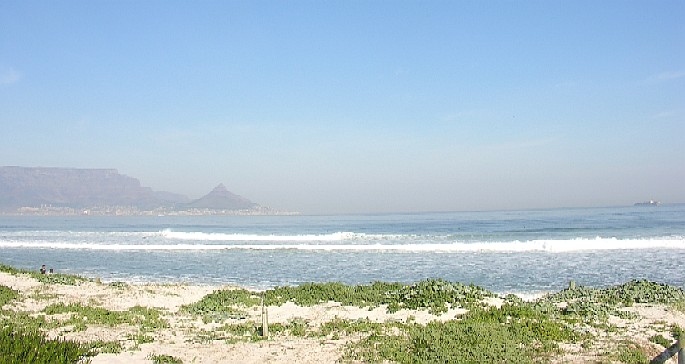
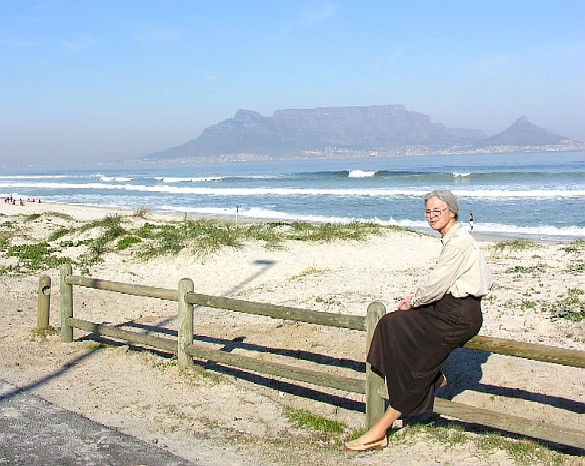
Wednesday 07-06
The owner of Villa Christina allows us to leave part of our luggage in our room and the room is promoted to our Western Cape base camp. We leave Cape Town 10.30 hours for Buchu Bush Camp in the most southern part of the Cape. A trip of some 300 km via Somerset West, Caledon and Swellendam. For the first time we pass shanty towns that have been upgraded recently and apparently some development progress has been made. Small stone houses with corrugated iron roofs, long rows of detached toilets, electricity, water and a sewage system. Certainly an improvement compared to the houses made of cardboard, wooden planks, sheets of plastic and rusted corrugated iron sheets. Still, even the upgraded shanty towns are not places where you would feel happy and at ease! From Swellendam, we hit a gravel road south towards the De Hoop Nature Reserve. For the first time since we are in Africa, we trail a cloud of dust and it is good to be on the real African dirt roads again. It is almost 40 years ago that Paul saw white farmers on horse back with saddle rifle holsters and here he sees them again. A rolling hill landscape with hazy blue mountains in the far distance and every 10 or 20 km a white washed Cape Dutch homestead characterises this part of the Cape. After 60 km of dust we arrived at the Bush Camp: marvellously situated in a “duinpannetjie” and completely remote from the inhabited world. A main building with a sitting and dining room and a kitchen and five 2-bedroom chalets. Rough but comfortable. A young Afrikaner girl from the village of Rivierseind, who has just been employed for a week, is in charge. We have a chat and a good meal before turning in. As it turns out, the staff all go home and the two of us spent our first night alone out in the bush some 10 km from the first house nearby. So much for the proverbial South African insecurity!
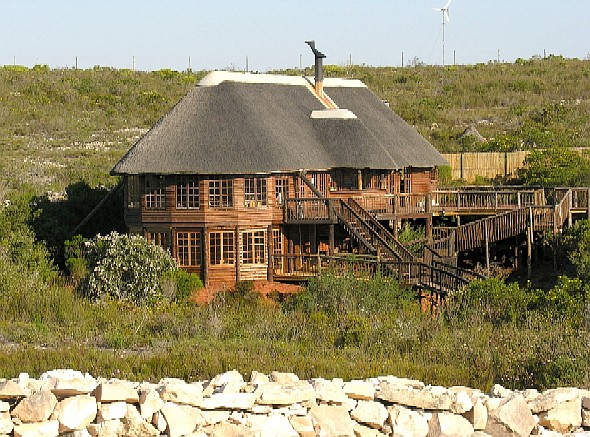
Thursday 08-09
Our idea is to visit the most southern village of Africa - Cape l’Algulhas - and once we leave the bush camp, we turn left to Welgeleë and Bredasdorp. An excellent but dusty dirt road carries us over rolling hills with just sown in wheat and barley. With his green felt hat and his white beard, Paul looks very much like a Boer and more than once we are greeted by oncoming traffic like we are new farming neighbours! Around 12.00 we are at Cape l’Agulhas (Cape of the Needle in Portuguese) where we have a light lunch. Since it is mid-winter here and completely out of the tourist season, the owner of the small pub first has to go to the butchery (slaghuis) to get the meat for our burgers! After lunch we decide to visit Waenhuiskrans, another small village along the coast. We walk the beach for half an hour and then return to Bredasdorp to buy some essentials at the local Super Spar. Once inside, we are not sure whether we are in Holland or South Africa. All but a few people shopping there are white and of our age and the assortment is equal to that at home. After a dusty drive we arrive back safely at the Buchu Bush Camp.
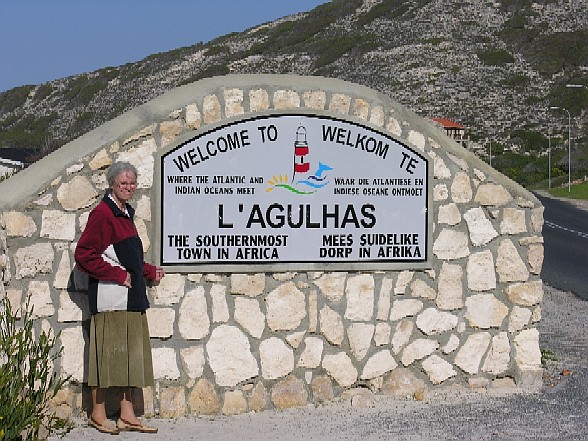
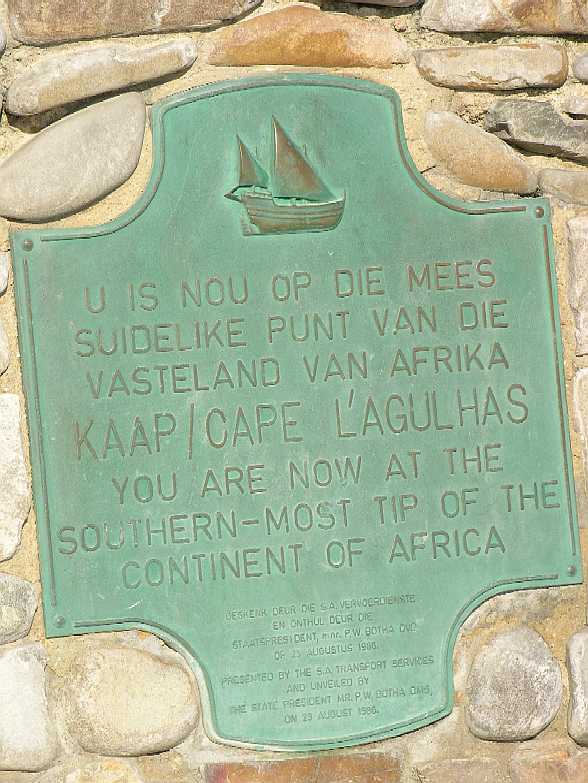
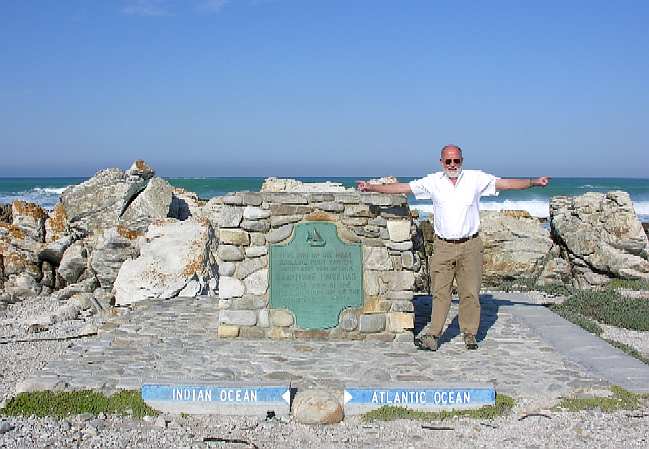
Friday 09-06
A cold morning, not more than 4 or 5 Centigrades and cold enough to light our gas stove. The Hoop Nature Reserve is a marvellous place: dune vegetation, blesbokken, turtles, ostriches, etc. After a long drive over a badly corrugated dirt road and a brief walk, we reach the Indian Ocean at “Koppie Alleen” and sit on a high dune watching sharks hunting smaller fish just beyond the surf. Meta is the first to spot two whales very near to the beach. With almost 14 metres length and a weight of over 30 tonnes, they are impressive indeed and we even manage to take photographs of their tails flipping above the water. Buttering your lunch bread (“boere brood en wors” from Bredasdorp) whilst watching playing whales in the Indian Ocean is an idiotic but fantastic Africa Tour experience! Back at Buchu Bush Lodge, it is really cold again and before diner we sit around the open fire and chat with the wife of the farming family owning and running the lodge: Annette van Eeden. The Van Eeden’s own a 700 hectare farm some 10 kilometres from the lodge and Annette’s husband is the 6th (!) generation farming this wonderful Southern Cape land.
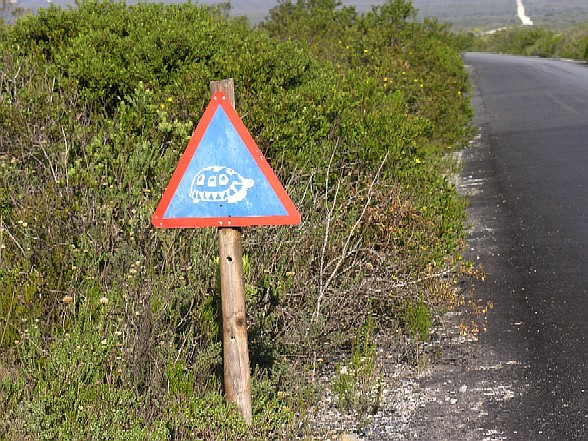
Saturday 10-06
In the morning we travel to Swellendam, another rather sleepy Cape village with beautiful old Cape houses. It is warm and sunny and we have lunch in the ivy covered garden of the Old Mill. “Goeie Kos van die Platteland” says the billboard and it is not far from the truth.
To our surprise we suddenly have mobile coverage and use the opportunity to speak extensively with Rimbaud at home and Remigius in Tanzania. After that the batteries are flat and we will have to wait for the Land Rover to arrive to charge our mobiles again (we put the charger in her electronics box, expecting to be in Cape Town only for a couple of days at most). On our way back to Welgeleë and Oudeplaats, we pass Malagas where we are put across the river by the only hand drawn ferry left in South Africa. Back at Buchu we enjoy a diner of tuna salad, springbok stew (“springbokpotjie”) and vanilla pudding and spend the rest of the evening chatting with the Van Eeden family. Wheat farming in this part of the Cape is highly mechanized and also the dairy cows, sheep and ostriches require relatively little labour. The Van Eeden’s farm 700 hectares and their labour - three coloured families - live on the farm. Some already for generations too. The farmer’s problems are partly of all ages: draughts and the fact that you cannot continue indefinitely (not even in Africa!) splitting up your farm between your sons. Back in our cottage we continue discussing land reforms. White farmers like the Van Eeden’s, not only provide South Africa with the much needed food, but also add significantly to South Africa’s export earnings. In addition, they create jobs and thus income and pay taxes which can be used for further development. The long run picture of some 7 percent of the population owning almost 70 percent of all arable land is a more complicated one and in the long run, we think, not tenable. On the other hand, Mugabe’s crazy land reforms in Zimbabwe were entirely power-politically motivated and brought the country to ruin by destroying its agricultural production capacity. If you give farms to your political friends, who are only interested in the nice homesteads and have no intention whatsoever to keep the land productive, the results are very predictable. If Africans are to farm in the same productive manner as the whites are presently, agricultural education is of paramount importance and access to reasonable credit facilities. Unavoidably all that, of course, will again take many years and will try the patience of people and that they are impatient we can understand. In short, and as usual, we find it hard to present solutions for Africa’s problems.
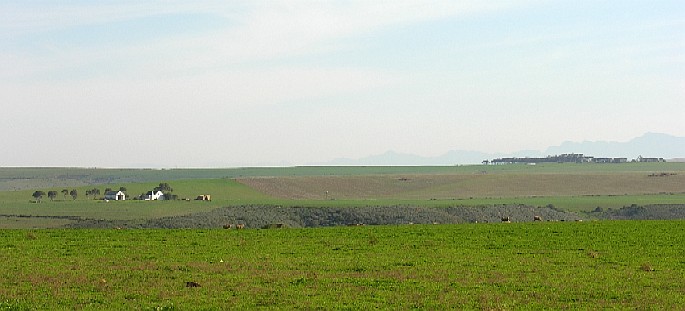
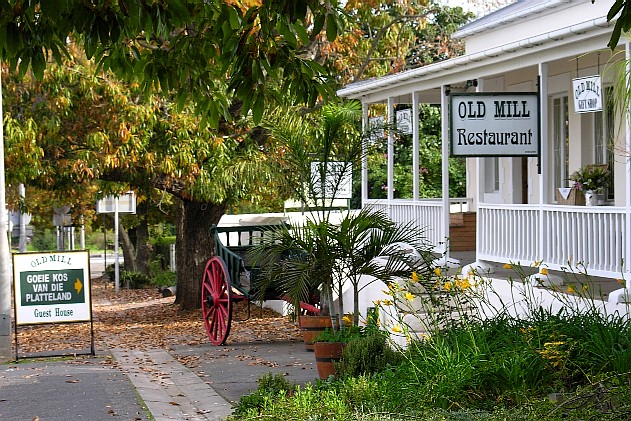
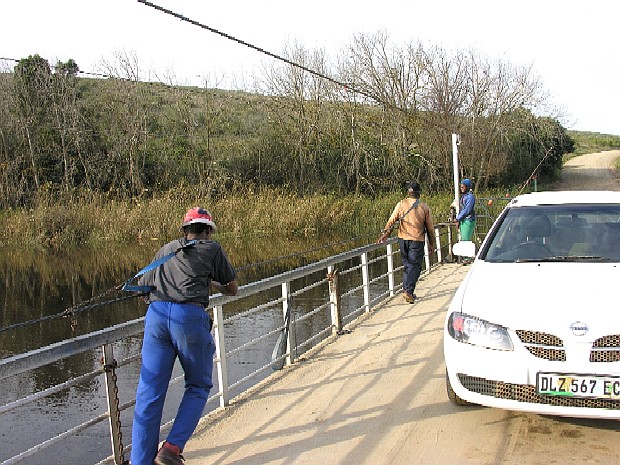
Sunday 11-06
An uneventful trip back to Cape Town via Bredasdorp, Napier, the Akkerdisbergpas and Hermanus. Somewhere near the Botrivier Vlei we have a Sunday lunch with other elderly white South Africans.
Monday 12-06
During the night the weather turns sour with heavy showers and a high wind. At 10.00 we call the woman from Inter-sped - the handling agent of our care in Cape Town - and learn that the Grey Fox has arrived but is only allowed to berth at 18.00 am. Although they assure us that the car will go into custom depot and can be released on Wednesday, we are still sceptical. In short, another lost day as far as the car is concerned. At the waterfront we buy some supplies (liver spread with onions, bread and some red and white wines) and find a bookshop selling bird an mammal guides of southern Africa. Meta buys her first two Afrikaner novels: Olive Schreiner’s “The Story of an African Farm” and Elsa Joubert’s “Isobelle’s Journey”. The elderly shop attendant turns out to be a Rhodesian woman, and we end up discussing the quality of grilled prawns at Johny’s Restaurant in Beira 35 years ago. The truth is often stranger than fiction! Around 11.30 we head East over the N1 to Stellenbosch, to have lunch again in the Stellenbosch Hotel. By 14.00, showers have given way to very heavy rains. Nevertheless we decide to explore the mountain range around Franschhoek, Moordkuil and Worcester. The weather deteriorates further and further and by the time we reach the N1 again, a gale 7 to 8 and unbelievable downpours have reduced road visibility to almost nil. After a rather scary 1 hour drive we manage to reach Cape Town safely.
Tuesday 13-06
Still rainy with heavy winds. In the morning we try to get camping gas and a South African type of reduction valve. Alas, to no avail. Instead we manage to buy flags of Namibia, Botswana, Zambia and Mozambique for the car’s standard! In the underground parking lot, the cell phone rings: the people from Intersped. Wa Bashasha will be ready for inspection in the harbour custom depot tomorrow at 14.00. Too good to be true!! Hopefully she and the roof tent have not sustained damage and hopefully customs are going to be lenient. Since the gates to the protected parking area of our guesthouse are not high enough, we have to find another solution to keep the car safe at night. A garage down the road, five minutes walk from our guesthouse, is so kind to offer shelter for Wednesday night! After that we take the axe with us in the roof tent. In the afternoon, we play tourists by visiting the National Botanical Garden at Kirstenbosch, some 20 minutes drive from the centre of Cape Town. We first have lunch at the Silver Tree restaurant in the Garden and then walk around and visit the conservatory.
Wednesday 14-06
Arriving at the Intersped Office at 13.30, we hear that they moved months ago to another place in town. Highly irritated we call them and they promise to send a driver to show us the way to their new office. That takes almost an hour and by the time we arrive at their new premises we are in a foul mood. An Intersped employee first collects a custom officer from town and then shows us the way to the South African Custom Depot (SACD) in the harbour. We arrive there at 15.15. At the end of an enormous hall, there is a ramp on which containers are opened. Wa Bashasha’s container still sits on a lorry, but an enormous grab-loader lifts the container from the lorry and dumps it at our feet. After the custom officer has broken the seals, we are allowed to open the doors and inspect the car. Notwithstanding the fact that the car is secured by cables and wheel locks, the right hand front body of the car is scratched and dented and also the roof tent has sustained some damage. A pity, but not of any operational consequence. The custom officer is pleasant and helpful and within 15 minutes the car and her contents are imported and all papers duly stamped and signed. After turning the key, the engine catches immediately but … dies after the first minute running. We have to push the car out of the container and are then informed that we have to leave the custom depot at 16.15 latest. At 16.00 it is obvious that Paul cannot find what is wrong and to our dismay we have to leave Wa Bashasha behind in the custom shed. We are both distressed and sleep badly.
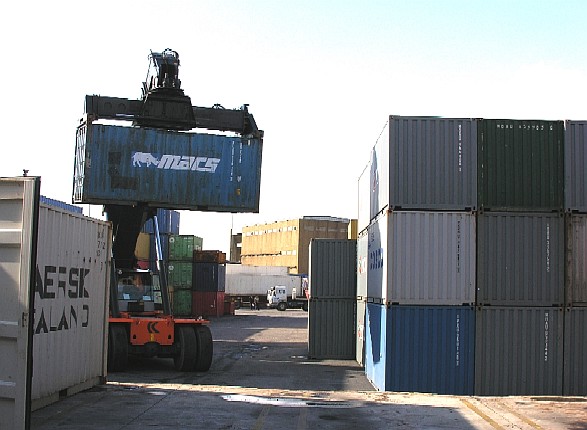
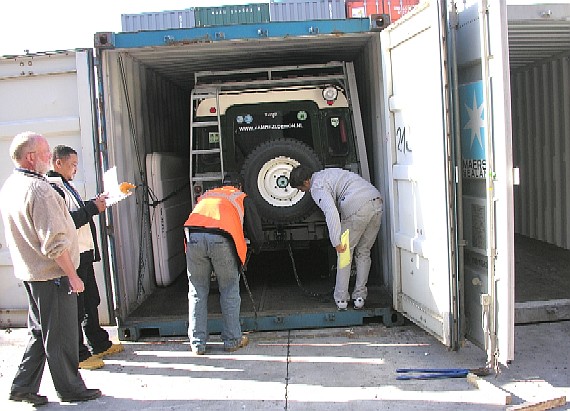
Thursday 15-06
At 08.00 we are at Intersped again – a little more cheerful - and they help us to locate the Cape Town main Land Rover dealer. The moment they hear that our car is a 1975 Series III, they lose all interest. Like bloody CITO in Eindhoven, they are apparently only interested in selling Rang Rovers and Discos to the greedy rich. Luckily one of their African mechanics is more helpful and tries to locate other garages that might know something about old Land Rovers. At that point, one of the customers - collecting his Range Rover - intervenes. He tells us loudly that the official Land Rover dealer is only interested in selling new cars. However, he knows a good garage capable to look after a Series. Eventually he even phones the owner of what we later learn is Jaba Motors and lends us his mobile to speak to the guy. Five minutes later we have arranged a towing truck to come the Custom depot and to get Wa Bashasha to Jaba Motors. It takes a while but at 09.30 the towing truck is allowed into the Custom depot and Wa Bashasha is winched aboard. At 10.00 we are at Jaba Motors.
The owner – Marc – is a pleasant guy, the place looks clean and the mechanics (black and white) competent. After some 15 minutes, they diagnose a faulty petrol switch of the two front petrol tanks. Luckily Paul has a spare switch in his magic box and we agree that we will fetch the car at 14.00 pm. At 14.00 pm we are at the garage again and the car is purring like a kitten!!! The gasket of the switch had succumbed to old age and/or to sitting unused for 5 weeks in a container. The new switch works and the old one is repaired to use as a spare. We pay and begin loading the car up. Un-strapping all the luggage, getting the baggage box and water tanks on top. When we are ready, Paul looks worried when he sees the car sagging on her rear parabolic springs. Already in Holland, Paul was far from happy about the posh parabolic springs, but Jansen in Oosterwijk managed to talk him out of his worries. Now the owner of Jaba Motors and his mechanics also mix in and express their worries about the (brand new) rear springs. According to them, the car will only get as far as the first really bad road somewhere in Namibia. They suggest that we mount inflatable aircushions to support the rear springs. These cushions operate on a compressor and can be adjusted according to the load. Since we have a 24V car, it is, however, difficult to find a compressor and eventually we decide to put inflatable aircushions under the car without a compressor. Since we don’t want to delay our departure to the north, we agree that the mechanics will make overtime and that we will collect the car somewhere later during the night. Marc brings us back to the guest house and we drop our Nissan Almera at Hertzs’. At 20.00, Marc from Jaba Motors calls us at the guest house to inform us that there is more engineering work to be done than he had initially thought. Since Friday is a public holiday, the car will only be ready somewhere on Monday. We are disappointed, but also satisfied that something is being done about the springs. We will kill another 3 days in Cape Town and have to get back to Hertz to hire another Nissan!!
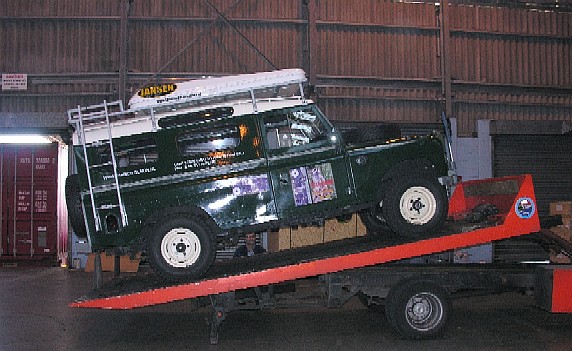
Friday 16-06
At 09.30 we are back at Herz Rental and pick up another Nissan. Then we set off to Noordhoek, where we have lunch before driving around the peninsula along the coastal road.
A quiet and uneventful day.
Saturday 17-06
Friday night we take the bold decision to travel from Cape Town to the Little Karoo, an isolated semi-desert mountainous area in the far East of Western Cape. A round trip of some 1000 km! Midday sees us in Swellendam, where we have lunch again in the Old Mill. Here we meet the owner: a single Belgian woman of 60 years or thereabout who bought the restaurant 6 years ago. At 14.00 we leave the main road at Suurbraak and head towards Calitzdorp, in the middle of the Little Karoo. Magnificent mountains all around us and when we near Oudtshoorn at around 17.30, light is fading quickly. After some discussion we decide to stay in the Queens Hotel. An old stately colonial affair with 40 rooms in which we are obviously the only guests. After a very pleasant filet dinner in a local restaurant and a bottle of De Kraal Chardonnay (with our age and looks everyone thinks we are a local “oupa” and “ouma”) we have a good night’s sleep.
Sunday 18-06
Breakfast in the imposing colonial breakfast room with a portly black cook preparing eggs and bacon for her only guests. At 10.00 we are on the road again towards the Swartberg Pass. A winding mountain dirt road leads us to well over 2100 m in a magnificent alpine landscape. Carefully - our Nissan is not a 4x4 - we find our way down to Prince Albert where we have lunch. Prince Albert is one of those sleepy Cape Villages again with white washed Victorian houses and flowering bougainvillea.
We are almost pulled out of our car by the staff of the Swartberg Hotel, another colonial affair from around 1900. We chat with the owner - an English South African - and sample some of his buffet lunch. At 14.00 we are on the N1 again in the direction of Worcester and arrive in Cape Town just before dark. Exactly 1068 km on the clock!
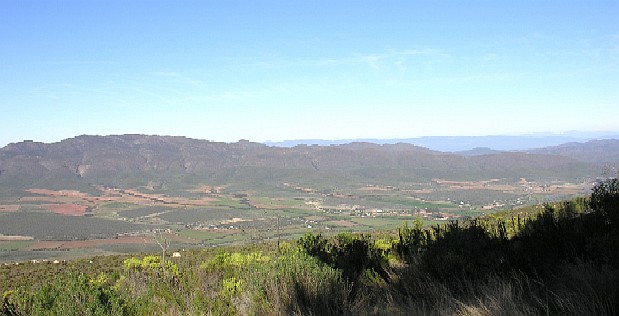
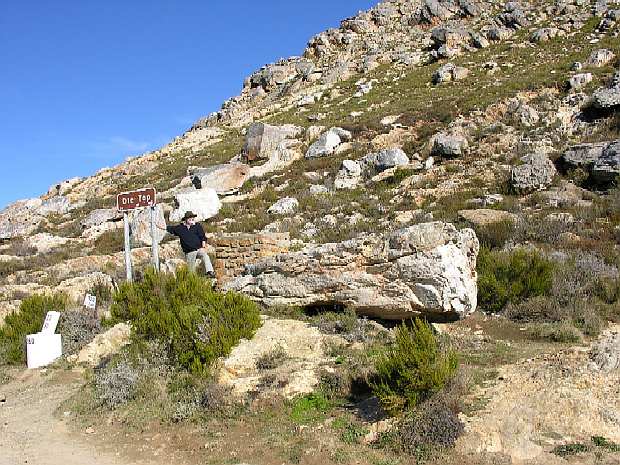
Monday 19-06
At 09.00 we are at Jaba Motors to check on the progress of mounting the air cushions under the rear springs. They are making good progress and we agree to pick up the car at 14.00 pm. When we arrive in the afternoon, the owner of the garage is just taking Wa Bashasha for a trial run. The car has gained at least 15 cm clearance and the whole construction looks solid. Two heavy duty Firestone airbags (40-100 psi) with gauges and air pressure valves on the instrument panel inside the car. At 16.00 we are finally loading the car up in front of the guesthouse. Paul pulls a muscle in his back when lifting one of the spare part boxes and is far from happy about it.
Tuesday 20-06 (320 km)
We have some problems getting out of Cape Town. The owner of the guesthouse and his wife take a keen interest in the car and we spent some time with them chatting and taking photographs. When we are almost ready to leave, one of the neighbours shows up (an African lady from Antigua) and before we have dealt with her, another hour has almost past. At around 10.30 we heading out of Cape Town and shortly afterwards we hit the N 7 north. Climbing up the Piekenaars Pass, just before getting into Glenwilliam, and some 200 km from Cape Town, the engine stalls. Paul lets the car roll back to a parking place a kilometre down hill (not a pleasant manoeuvre since the power brake system is incapacitated because the engine is not running). Apparently we still have a petrol line problem! We have lunch and then start the car again. It runs, and we continue our way to Vanrhynsdorp where we arrive at 16.00. Vanrhynsdorp is a typical Spartan settler village and we drive around looking for a guesthouse. Lombards guest house is a Cape Dutch house from 1946 with a magnificent “stoep” and after we have viewed the room we decide to stay. The owner shows us his hunting trophies and photographs and he and Paul discuss Mauser hunting rifles. We have diner at the only restaurant in the village, the Namaqualand Country Lodge. Afterwards we sit on the “stoep” of our guesthouse, drink some wine and chat with other South African guest who present us with a bottle of white Chardonnay wine.
Wednesday 21-06 (260 km)
At 10.00 we are on the road again to Springbok. A magnificent trip through Namaqualand via Nuwerus, Bitterfontein, Garies, Kakamas, Kamieskroon en Mesklip. Just before Mesklip we drive over the Burke’s Pass and although we only drive 50 km an hour, we reach the summit without further problems. It is still early, around 14.30, when we arrive in Springbok and start looking for a guest house. We end up in the Desert Rose, a small place just off the road to Upington. Parking Wa Bashasha is a bit of a problem, because of the very steep hill against which the guesthouse is built, but eventually we manage. Family Van Zyl is very sociable and Paul ends up admiring the freshly made sausages (part of a cut sheep is still on the kitchen table) and the springbok biltong. At night, in the pitch dark, we walk some kilometres to the centre of Springbok and dine in a steak house. From the outside a rather grubby affair, but the food is excellent and certainly plentiful.
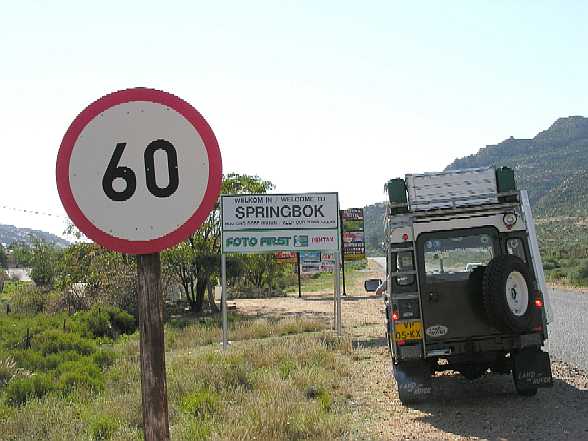
Thursday 22-06 (395 km)
In the morning we have an enormous breakfast and before we have extracted ourselves from the Desert Rose, it is 10.00 again! The N14 to Upington runs through the almost empty and semi-desert Northern Cape and the names of some of the villages we pass tell the story of this empty land: Uitkyk, Houmoed, Pofadder and Bladgrond. At Kakamas, we pick up the Orange River, still holding quite some water at this time of the year, and the landscape changes rapidly. Within a couple of kilometres we see the first vineyards again. At Keimoes we take in petrol and some supplies and an hour later (16.00) we are in Upington. Unlike Vanrhynsdorp and Springbok, in essence still frontier settler villages, Upington is a real small town of its own. We drive around for a while (entering the town there are no advertisements for guesthouses) and finally find an old house in a suburb: Classic Court Guest House. Our room is clean and spacey, but the plaster is coming of the walls, in the bathroom the water drips through the ceiling and our first cockroach is hiding behind the mirror. Those, however, are minor inconveniences. The cold is not, and when we wake up in the morning there is ice on the grass. The owners of the place, de Du Toit family, have moved from Limpopo to the Northern Cape for security reasons and now enjoy the relative peace and lack of violence in Upington. Chatting with them after breakfast, they think that it will take another 3 to 5 years before the violence reaches the Northern Cape. Like almost everywhere in South Africa, the “angst” of the whites is apparently part of daily life!
Friday 23-06 (250km)
The N14 from Upington to Kuruman is a deserted stretch of road with only Olifantshoek as an in between stop. We are clearly on the southern fringes of the Kalahari desert and the land becomes drier and drier. Somewhere halfway, we rig up the satellite phone and try to contact Pieter Pretorius in Pretoria. Luckily we are successful and hear that Pieter and his family will meet us in Kuruman. Pieter suggests that we stay in the Red Sands Country Lodge, some 15 km West of Kuruman and the satellite telephone also links us up with these people. They still have a cottage free. At 15.00 we leave the N14 and hit a real Kenya like murram road. For the first time in her life, Wa Bashasha is trailing the red laterite dust she will have to get accustomed to during the rest of our tour. A corrugated track takes us up the Kuruman Hills and before long we see the beautiful thatched buildings of the lodge. By the time we have unloaded our travel bags and reorganised the roof rack arrangement, it is getting dark and the temperature plummets to the freezing point. We have diner in the restaurant and, notwithstanding the blazing gas fires there, turn in shivering!
Saturday 24-06 (80km)
Since Pieter and his family are only expected to arrive around 14.00, we drive the 15 km to Kuruman and do some shopping there. We buy some bottles of wine (expecting Pieter to give us no choice but to have a “braai” later during the day) and wonder whether we should buy meat as well. Knowing our Afrikaander friends, we decide to leave the steaks and chops to them. Shortly after 15.00, Pieter’s Toyota Landcruiser rolls in and 4 years after visiting the village of his ancestors in Zeeland together, we see each other again. Mariana had to stay home, but Tandie (14) and Pieter-Jan (4) have come with Pieter Pretorius. We chat and, yes you guess right, have a “braai” at sub-zero temperatures. Later we sit on the terrace outside with two fleece jackets and two pair of socks, and continue chatting. When we turn in, our teeth are rattling!
Sunday 25-06 (80km)
Sunday morning we are off to Moffat’s Mission Station some 5 kilometres north of Kuruman. Moffat was one of the early missionaries in this part of the world and if you want to read more about him, you have to read the history of the mission station in chapter 1 (Bird’s Eye View of African History) of Paul’s new book. The Kuruman Station was also the first posting of David Livingstone. When he was attacked and mauled by a lion there, Moffat’s daughter, Mary, nursed him. Eventually the two married and in two months time you will read about the end of this story when we drive into the tiny village of Shupanga in Mozambique. Here, in a small graveyard, under an age-old African fig tree, Mary Livingstone was buried. An hour after we leave the graveyard we will drive into Marromeu and the day after, hopefully, we are back home in Luabo!! Moffat’s Station reminds us again of the policy of apartheid and particularly of its multitude of unnecessary discriminatory and sometimes even downright idiotic laws. After its start somewhere around 1820, the Mission Station had to close down in the mid-1960s, when the Land Occupation Act was passed, forcing coloureds and blacks to move to newly allocated areas (homelands)! After lunch at the Red Sands, we leave for Kathu, some 30 kilometres south of Kuruman. Near Kathu is one of the largest open pit iron mines in the world. We admire some of the gigantic machinery used to excavate and transport the iron ore and explore the (white) mining village. In the evening we have a sub-zero temperature “braai” again and a very pleasant chat with the Pretorius family. As ever, the problem is that, in many ways, we feel connected to our Afrikaander friends and understand their problems and worries, whilst at the same time we feel more at home in black Africa and understand our black African friends. Will we ever reach the state of wisdom??
Click on the images for the enlargements
Monday 26-06 (40km)
Not a very eventful day. In the morning we see Pieter and his children off, do some shopping in Kuruman and repack the car. As it is, we have far too much luggage and eventually we manage to fill two large bags with clothes and give them to the servants in the Red Sands lodge. During the night, a storm begins blowing and in the morning it is freezing cold.
Tuesday 27-06 (370km)
We leave at about 10.00 and travel all the way back to Upington via Kathu and Olifantshoek. From Upington we even drive back to Kakamas, before turning right on the road to the Augrabies Falls National Park along the Orange River. Due to all the excellent tarmac roads, we arrive at the gates of the park early and manage to get a beautiful self catering cottage close to the Augrabie Falls. We unpack our two clothing cases and the kitchen and food boxes. Then we change our mind and book a table in the restaurant. Excellent food and together we almost manage to finish a bottle of Nederburg Paarl Riesling.
Wednesday 28-06 (50km)
We spent the morning exploring the Augrabies Falls National Park. Due to the unusually heavy rains in March, most of the park’s roads have been washed away and the 4x4 tracks are therefore limited. After we have crossed a river with almost a meter of rapidly flowing water, we drive to the Moon Rock, park our car there and climb the rock. On the way we take some photographs of the klip dassies (hyraxes). From the Moon Rock we drive to where the roads are washed away and then return and visit the Echo Corner with a beautiful view of the Orange River gorge. As a bonus we meet some impalas, duikers and steenboks. Back in the camp we decide to have a braai en buy some meat, charcoal and lighter tablets. Later that night, in the freezing cold, we have our braai and then turn in under two blankets. Still, next morning Meta is complaining about cold feet.
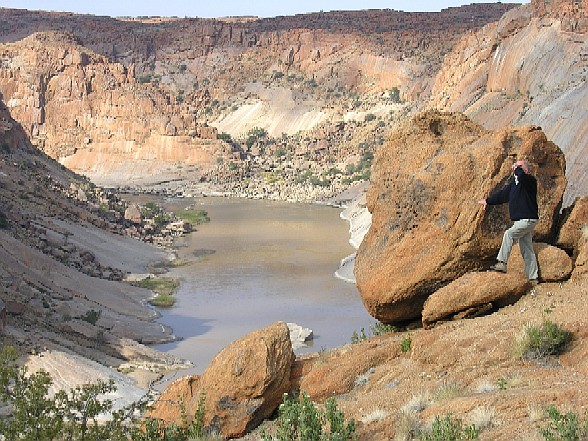
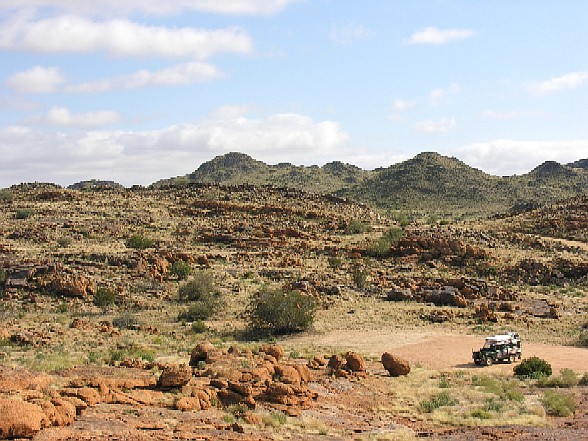
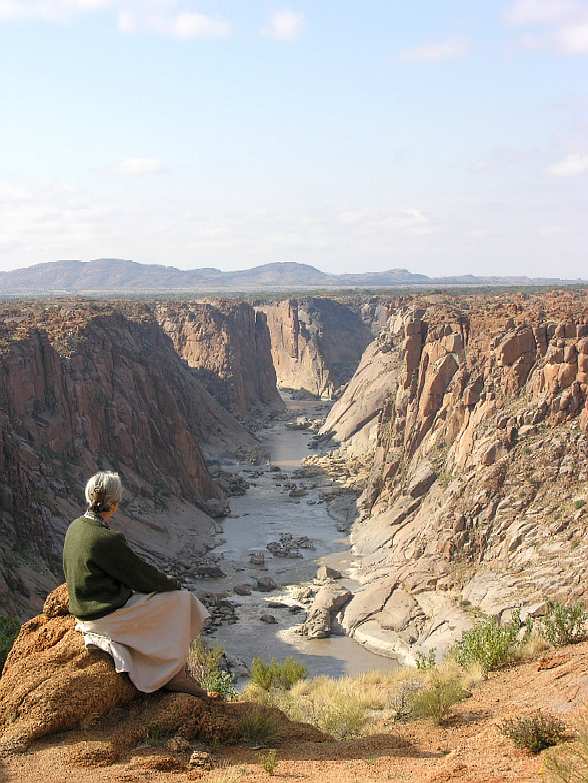
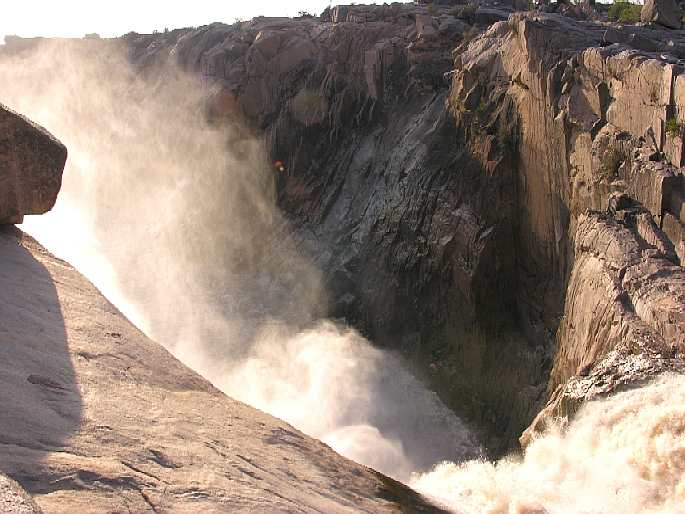
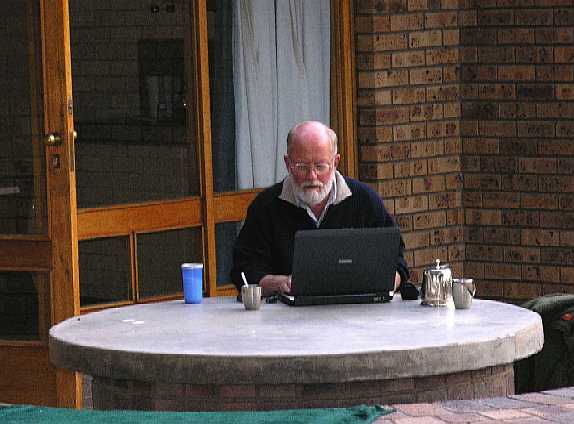
© 2005-2006 Paul and Meta Lapperre - Website by MvS
